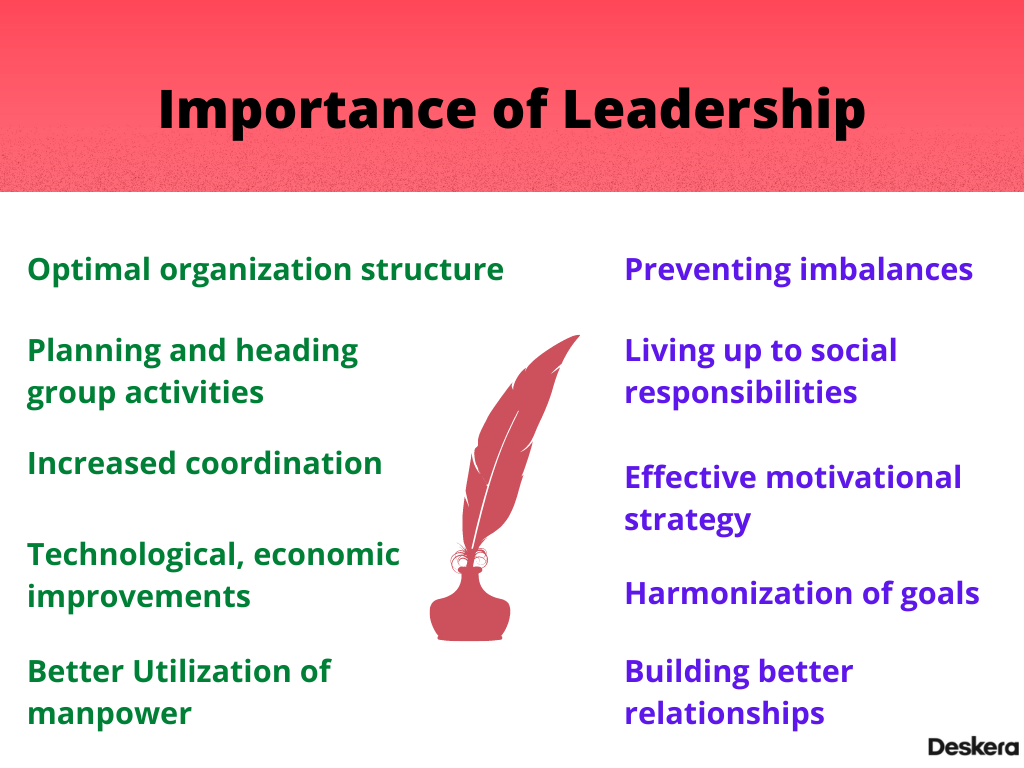A Leader is one who knows the way, goes the way, and shows the way. - John C. Maxwell
How would you define a good leader? Someone who can inspire, empower and steer the team towards enriched performance and outstanding outcomes can possibly be the quintessential definition of a leader. A leader knows when to be assertive and when to be adaptable. They understand the team’s capabilities and motivate them to enhance performance and achieve the higher ground.

The roles and duties of a leader are not confined to a definition. They need to juggle various roles and don diverse hats. From difficult decision-making to propagating positive thinking are only a few points that lay down the importance of a good leader. They have to count and consider the opinions of everyone involved in the process.
This article aims to serve as a guide to effective leadership and all the other qualities that are of utmost importance to the role of a leader.
Let’s see the points that are covered in the article:
- How important is leadership?
- Basic Prerequisites to become a Good Leader
- 10 Tips to Become an Effective Leader
- Signs you Need to Upgrade Your Leadership Style
- Super Tip: Consolidate Leadership Styles
- Conclusion
- How can Deskera Help You?
- Key Takeaways
How Important is Leadership?
A team that works well together and consistently gives performance no matter what the situation is indicates being guided by a remarkable leader. We can find many inspirational leaders in the world today across various professional fields.
Whether you are planning to optimize the work structure or trying to prevent imbalances within the organization, leadership takes up an eminent role in managing things. The following image highlights the importance of leadership:

Here's an overview of the factors that can be achieved through effective leadership:
- Optimal organization structure
- Increased coordination
- Planning and heading group activities
- Technological, economic, and social improvements
- Utilization of manpower more effectively
- Preventing imbalances
- Living up to social responsibilities
- An effective motivational strategy
- Harmonization of goals
- Building better relationships with others
Basic Prerequisites to become a Good Leader
As easy as it was to jot these points in the previous section, these are the possibilities that materialize only in the presence of a great leader. While some people may have a few qualities that led them to make effective decisions, leadership traits can be acquired by anyone who is determined and wishes to make the much-needed change in their professional ecosystem.
Here are the basic qualities that you shall find in a great leader:
- Uniting and synergizing people or the team to accomplish a common goal
- Be a source of inspiration, a role model for all
- Great leaders have impeccable communication skills and they respect others' opinions
- They are someone who the people trust and count on for effective decision making
If you want to become a leader who inspires others, you first need to start adopting these qualities and showcase them as an integral part of your work.
10 Tips to Become an Effective Leader
Analyze Your Leadership Style
Becoming a leader starts with knowing your strengths and weaknesses. That shall come with a self-analysis. Unless you have analyzed the pattern of the ways you handle things as a leader, it could be difficult for you to stand out as a good mentor or leader.
You could be a leader who has the final say while making decisions, or you could be someone who lets the team members make their own decisions. You could be someone who rarely considers others’ suggestions or someone who believes that collaboration is the way forward. So many contrasting traits, yet all seem to work given the kind of challenge or scenario you face!

In a situation when you spot a team member’s mistake, how do you handle it? Do you punish them or reprimand them, or provide them with guidance to avoid such errors in the future? There are many instances like these that you can write down and understand your way of doing things at work.
All these, along with many other aspects, can drive you to the conclusion that helps you know your current leadership style. Also, it can enlighten you about your shortcomings and the areas where you need improvement.
Communicate Effectively
Effective communication is a crucial leadership skill. Good communication is not confined to just listening and responding. It also includes sharing valuable information and inputs. As a leader, you must participate in intelligent questions, help generate new ideas, and also dispel misconceptions. Furthermore, your role as a leader requires you to put forward your thoughts very clearly. Clear and effective communication can improve your workflow to a great extent.
Clear Communication drives the following:
- Quick problem solving
- More productivity
- Better control over the tasks
- The enhanced professional reputation of the leader
- Strong Decision-making skills
- Elicits better response from clients and customers or stakeholders
Mastering the art of good communication lets us be assertive without offending anyone. You can not only propose new ideas to your seniors but also put across constructive criticism to your subordinates. This not only sets the momentum for clear communication but also persuades your subordinates to share their vision and ideas. Clarity can pave the way forward towards better and sooner goal achievement.
Exude Zeal and Enthusiasm
Would you follow a leader who is dull, aloof, and detached from work? You would probably not look up to them and would not approach them for any guidance. Good leaders, on the contrary, offer complete devotion to their work; they are passionate about it.
Their enthusiastic and zealous perspective propagates over to the team and helps them take on challenges with confidence. One way you can achieve this is by discussing things and improving transparency within the team. Let your team know about your genuine admiration for the work you do. Align them with the common goal of hitting targets for the organization’s growth.
While you are at it, ensure that you are sincere. Insincere leadership is easily recognized by employees. A leader's passion and enthusiasm, however, are contagious when they are genuine. When leaders are enthusiastic, they are able to spot potential problems in their sphere of influence.
Make Hard Decisions
In order to be a successful leader, it is essential to possess the capability of making rapid, difficult decisions under challenging circumstances and limited information. Identify your goals when you are facing a difficult decision. Once you have identified them, dedicate yourself to accomplishing those goals.
It is not going to be easy to make such decisions. However, as a leader, you must take into account the effect your decision is going to have on you, the organization, and others. Stakes could be very high, and therefore, you must take into account all the aspects before coming to a conclusion.
Goal achievement can happen only when you have made consequential decisions. Weigh your options and decisions, consider the likelihood of their success, and move ahead with a firm mindset.
Understand the possible consequences of your decision and take responsibility for the outcomes. When you make a bold, confident decision, you'll be able to seize opportunities, move swiftly towards success, and cultivate a sense of respect from others.
Encourage Positive Attitude
Leaders who wish to bring about a transformation in their staff's way of thinking persistently have an optimistic attitude. It is only about what they do that will be emulated by the team, after all. When leaders become despondent and weary, their subordinates or followers are likely to follow suit. It is all about the leader's charisma that drives the team.
Here is how positive thinking can be advantageous:
Try to remain positive even when the situation looks bleak, and things seem to be moving out of hand. Keeping a positive attitude does not imply a make-believe rosy situation. It does not mean you overlook the obvious and continue with routine as if nothing happened. Indeed, there are times when things look impossible.
As a matter of fact, these are the times when keeping a positive attitude is most required. Leaders need to work hard, strive to reinstate the confidence in their team, and move on with hope.
Also, you will be able to recognize that things may not always be rosy, but with a positive outlook, you can pursue your team to address their shortcomings. At the end of the day, it's all about positivity and driving optimism throughout the organization.

Motivate People to Contribute
Within a team, you will find all kinds of people. Some are shy, some outgoing, some are proactive, while some others may need a bit of coaxing to contribute. Your job as a leader would be to inspire one and all to put their best foot forward.
This applies to all the extroverts as well as the introverts in the team. You may have to deal with each person differently. Instances like these will test your capabilities as a leader. You have to communicate to people who are underperforming or need guidance without making them feel inferior in any way.
Remember, motivation has multiple benefits. With motivation, you can deliver the following:
- Ideas
- Great performances
- Support to other employees, colleagues, subordinates
- Goal achievement
- Have higher confidence to deal with challenges
- Accomplish successful outcomes
When you recognize a member not being able to perform well, talk to them. Talking and having a deep discussion can iron out a lot of creases easily. Understand if they have been facing any personal issues or if they are under emotional stress. Sometimes there may not be an issue, and you just have to let the individual know that their deficiencies or gaps are being noticed.
This could be a tricky situation, but you must know how to inform them about it without going too far, as that may backfire and further lead to lagging performance. The idea is to keep the motivation quotient high and boost the team’s conviction.
Recognize and Reward Good Work
You must understand that your employees crave recognition for their work from you. The reason is quite obvious; they want validation of the work they are doing. Leaders must grasp that recognizing and rewarding the team members with the deserved praise boosts their productivity and overall spirit to perform better.

Moreover, when your team notices that they are being showered with due appreciation, they instantly want to repeat their performance.
Here is how rewarding them can benefit:
You must make arrangements to initiate such a process. After all, it is not only for guidance that your employees will turn to you. Their hard work needs to be rightfully recognized and appreciated.
Lead by Example
Leadership that transforms exemplifies the behaviors and characteristics that it encourages in others. People who lead by example are believed to inspire others; simply because they walk the talk. Consequently, group members emulate the behaviors of these leaders.

Leadership is all about setting examples and showing others how to do it. As a leader, when you want to drive important changes within your team or your organization, you will have to clearly demonstrate the behavior so that people can learn and follow.
Here are our 3 tips for leading by example:
There are situations when you need your team to put in that extra effort. In such scenarios, you, the leader, must also be ready to go the extra mile and show commitment towards the task. When the team knows how much the leader strives, they shall be better prepared to put in more initiative. Aligning your words and actions will help build trust and make your team more inclined to follow your example.
Leaders have the ability to transmit inspiration to their followers by cultivating productive ideas. This results in followers who are optimistic and hold themselves to finesse and excellence.
Demonstrate Integrity
Integrity is a characteristic of a leader who uses his values to guide his decisions, actions, and interactions. Loyalty, honesty, respect, accountability are all values that express integrity.
When leaders with these qualities execute decisions, they are absolutely certain about the choices they have made and the possible outcomes they may have. Following a principled path and maintaining ethics consistently throughout their work are the factors that define their integrity. They exhibit dauntlessness and an earnest attitude that keeps them grounded.
You can be considered a leader who demonstrates integrity if you possess the following qualities:
- Gratitude for others
- Honoring truthfulness and transparency
- Being accountable
- Being respectful towards all
- Establishing trustworthiness and reliability
- Being patient and agile
The strength of their character is undefeatable, and they honor their commitments. Through effective interaction, they are able to explain their stance clearly and display integrity through their behavior while dealing with their staff.
Be a Good Listener
Leaders don’t only give orders and guidance. They need to be good listeners as well.
You will find a lot of types of listeners. Some listen only when they need to. Then there are others that listen because they are truly interested and curious. Listening can be a terribly undermined quality, but we must learn that it can be an extremely crucial trait in certain scenarios.
Here are the signs you are a good listener:
- You're living in the present
- You're invincible against distractions
- You’re inquisitive
- You are not prejudistic
- You ask the pertinent questions
- You respect other opinions
- Interrupting is not your style
You can never know what ails a team member unless you are all ears. You must express yourself well and let them know that you are available to listen out to their dilemmas, queries, fears. To sum up, your team believes that they can share with you what they must and that you are approachable.
Signs you Need to Upgrade Your Leadership Style
All leaders have to face a time when they need to introspect. Unsurprisingly, introspection leads to improvement. The need to improve drives you towards upgrading your leadership style. However, there are various signs and signals that you can receive from the way your team works, which can lead you to take steps towards working on your leadership style.
Here are some of the shortlisted factors which help you see things in a brighter light:
Consistently underperforming team
It is normal not to meet your goals sometimes. However, if that becomes a norm with a team, then you certainly need to check what's wrong. You may need to discuss more attainable goals with company leaders. Or, it could indicate that you must put it across to your team to buckle up.
Inactive and uninvolved Team
Having a disengaged or uninterested workforce can stem from everyone doing the bare minimum, doing their assigned work without going above and beyond. Despite being a leader, you are not adequately offering adequate motivation and giving them the tools to succeed.
No inputs from the team
In team meetings or discussions, when none of your team members have anything to say or share or even raise a doubt, then it could possibly be that they are uncomfortable. This could be due to shyness, introverted nature, or any other reason. But as a leader, it is your job to encourage everyone to come up with ideas, or at least initiate a discussion for all to participate in.
After all, a healthy discussion leads the way towards better collaboration and cohesive success.
Low promotion rate
Leadership involves developing team members, building career paths for them, and sponsoring them for promotions when it is appropriate. It may be necessary for you to address employee development if your team has a low promotion rate.
Super Tip: Consolidate Leadership Styles
Each leader approaches management differently. There are many leadership styles in management, just as there are as many people in management. Although some managers have similar styles, there could be slight variations in the execution of ideas. To get the best out of all the leadership styles, you will have to adopt the best points of each of them. In the professional sphere, we can commonly observe the styles mentioned in this section. Let's take a look.
Autocratic Leadership Style
Leaders who are autocratic, also known as authoritarian leaders, have complete control over workplace decisions. In this environment, members are not allowed to contribute; instead, they must obey all decisions and orders from their leader.
Democratic Leadership Style
Democratic leadership has many characteristics that contrast with autocratic leadership. An example of democratic leadership would be when the leader involves team members in decision-making. Leadership decisions are final, but team members' input is considered as well.
Transactional Leadership Style
Transactional leaders tend to use incentives and punishments to boost productivity. They use these techniques to motivate employees as employees often face a challenging and rigid work environment. A few of the benefits included with transactional leadership are:
- Setting clear short- and long-term goals
- Establishing clear rewards and consequences for meeting the goals
- Streamlining and optimizing the chain of command
Transformational Leadership Style
An employee who works for such a leader is guided by a clearly defined vision for success. This style of leadership is characterized by:
- Setting a positive example for others
- Maintaining a constant focus on the company's goals
- Placing emphasis on interpersonal relations
- The use of inspiration to motivate employees
Conclusion
Different organizational environments call for different leadership styles to succeed. We have observed how various leaderships affect the processes and outcomes in a company. While you may have a unique style, it is wise to take away something from each of these styles to implement in your work area. This way, you can face all sorts of challenges and yet, emerge a winner, earn your team’s respect, and swiftly move towards grander victories!
How can Deskera Help You?
Deskera People allows you to conveniently manage leave, attendance, payroll, and other expenses. Generating pay slips for your employees is now easy as the platform also digitizes and automates HR processes.

Key Takeaways
Key takeaways from the post are:
- A team that works well together and consistently gives good performance no matter what the situation is indicates being guided by a remarkable leader
- Utilization of manpower more effectively, preventing imbalances, living up to social responsibilities, an effective motivational strategy are some of the benefits of an effective leadership
- The basic qualities that you shall find in a great leader are uniting and synergizing people or the team to accomplish a common goal, being a source of inspiration, a role model for all, having impeccable communication skills, and they respect others' opinions
- Analyzing your leadership style is the first step to becoming a good leader. Unless you have analyzed the pattern of the ways you handle things as a leader.
- Good communication plays a vital role. Effective communication is a crucial leadership skill. Good communication is not confined to just listening and responding. Furthermore, your role as a leader requires you to put forward your thoughts very clearly
- A leader must exhibit enthusiasm. Their enthusiastic and zealous perspective propagates over to the team and helps them take on challenges with confidence
- Leaders should be capable of making hard decisions. Goal achievement can happen only when you have made consequential decisions. Weigh your options and decisions, consider the likelihood of their success, and move ahead with a firm mindset
- Leaders who wish to bring about a transformation in their staff's way of thinking and working persistently have an optimistic attitude
- You should be able to persuade and motivate your team to contribute. Your job as a leader would be to inspire one and all to put their best foot forward
- Leaders must also recognize and reward their teams. Doing so motivates them, enhances performance, positively impacts business, and drives optimistic results
- Result-oriented Leadership exemplifies the behaviors and characteristics that it encourages in others. They are viewed as role models. People who lead by example are believed to inspire others; simply because they walk the talk
- Integrity is a characteristic of a leader who uses his values to guide his decisions, actions, and interactions. Loyalty, honesty, respect, accountability are all values that express integrity
- Leaders don’t only give orders and guidance. They need to be good listeners as well. Your team must believe that they can share with you what they must and that you are approachable
- The most commonly identified types of leadership as Autocratic, Democratic, Transactional, and Transformational. It is advised you have a mixed bag which offers you a wide horizon of ways to apply in your work
Consolidating the different kinds of leadership styles can also be a good idea, depending on the intensity of challenges you face.
Related Articles













